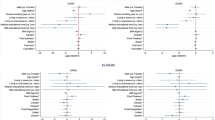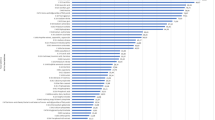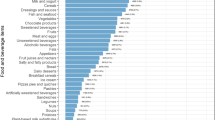Abstract
Background/Objectives:
Acrylamide, a probable human carcinogen, was detected in various heat-treated foods such as French fries and potato crisps. Recently, positive associations have been found between dietary acrylamide intakes, as estimated with a food frequency questionnaire using an acrylamide database, and cancer risk in some epidemiological studies. As acrylamide levels vary considerably within the same type of foods, a validation study was performed to investigate whether use of an acrylamide food database containing calculated mean acrylamide content, based on extensive sampling and chemical analysis of Dutch foods (several samples per food), can classify subjects with respect to true acrylamide intake.
Subjects/Methods:
We used the data from a 24-h duplicate diet study. The acrylamide content of 39 Dutch 24-h duplicate diets collected in 2004 was estimated using the mean acrylamide levels of foods available from the database and the menu list, on which the participants of the duplicate diet study had listed the amounts of individual foods and drinks in household units. Next, the acrylamide content of the total duplicate diets was analytically measured and correlated to the estimated acrylamide contents.
Results:
The Spearman's correlation coefficient between chemically determined acrylamide content and the calculated acrylamide content of the duplicate diets was 0.82 (P<0.001).
Conclusions:
This study indicates that it is possible to classify subjects with respect to acrylamide intake if mean instead of actual content of each food is applied. The database can therefore be applied in epidemiological studies on acrylamide intake and cancer risk, such as the Netherlands Cohort Study on Diet and Cancer.
This is a preview of subscription content, access via your institution
Access options
Subscribe to this journal
Receive 12 print issues and online access
$259.00 per year
only $21.58 per issue
Buy this article
- Purchase on Springer Link
- Instant access to full article PDF
Prices may be subject to local taxes which are calculated during checkout


Similar content being viewed by others
References
Anonymous (2007). Acrylamide levels in foods on the Dutch Market. Food and Consumer Products Safety Authority (VWA). Report, April 2007 (in Dutch).
Bjellaas T, Olesen PT, Frandsen H, Haugen M, Stølen LH, Paulsen JE et al. (2007). Comparison of estimated dietary intake of acrylamide with hemoglobin adducts of acrylamide and glycidamide. Toxicol Sci 98, 110–117.
Brantsaeter AL, Haugen M, de Mul A, Bjellaas T, Becher G, van Klaveren J et al. (2008). Exploration of different methods to assess dietary acrylamide exposure in pregnant women participating in the Norwegian Mother and Child Cohort Study (MoBa). Food Chem Toxicol 46, 2808–2814.
CIAA 2009. Acrylamide ‘Toolbox’: the European food and drink industry (CIAA). CIAA: Bruxelles.
Doerge DR, Young JF, Chen JJ, DiNovi MJ, Henry SH (2008). Using dietary exposure and physiologically based pharmacokinetic/pharmacodynamic modeling in human risk extrapolations for acrylamide toxicity. J Agric Food Chem 56, 6031–6038.
EFSA 2008. Acrylamide carcinogenicity new evidence in relation to dietary exposure. Summary Report EFSA scientific colloquium no. 11. 22–23 May 2008, EFSA: Tabiano (PR), Italy.
EFSA 2009. The EFSA Scientific Report (2009). Scientific Report of the European Food Safety Authority prepared by Data Collection and Exposure Unit (DATEX) on ‘Monitoring of acrylamide levels in food’. 285, 1–26.
Donders-Engelen M, van der Heijden L, Hulshof KFAM (2003). Maten, Gewichten en codenummers. Landbouwuniversiteit Wageningen: Afdeling Humane Voeding: Wageningen.
Fohgelberg P, Rosén J, Hellenäs KE, Abramsson-Zetterberg L (2005). The acrylamide intake via some common baby food for children in Sweden during their first year of life—an improved method for analyses of acrylamide. Food Chem Toxicol 43, 951–959.
Goldbohm RA, van ’t Veer P, van den Brandt PA, van ’t Hof A, Brants AM, Sturmans F et al. (1994). Reproducibility of a food frequency questionnaire and stability of dietary habits determined from five annually repeated measurements. Eur J Clin Nutr 48, 253–265.
Goldbohm RA, van ’t Veer P, van den Brandt PA, van ’t Hof A, Brants AM, Sturmans F et al. (1995). Reproducibility of a food frequency questionnaire and stability of dietary habits determined from five annually repeated measurements. Eur J Clin Nutr 49, 420–429.
Hogervorst JG, Schouten LJ, Konings EJ, Goldbohm RA, van den Brandt PA (2007). A Prospective Study of Dietary Acrylamide Intake and the Risk of Endometrial, Ovarian and Breast Cancer. Cancer Epidemiol Biomarkers Prev 16, 2304–2313.
Hogervorst JG, Schouten LJ, Konings EJ, Goldbohm RA, van den Brandt PA (2008a). Dietary acrylamide intake and the risk of renal cell, bladder, and prostate cancer. Am J Clin Nutr 87, 1428–1438.
Hogervorst JG, Schouten LJ, Konings EJ, Goldbohm RA, van den Brandt PA (2008b). Dietary acrylamide intake is not associated with gastrointestinal cancer risk. J Nutr 138, 2229–2236.
Hogervorst JG, Schouten LJ, Konings EJ, Goldbohm RA, van den Brandt PA (2009a). Lung cancer risk in relation to dietary acrylamide intake. J Natl Cancer Inst 101, 651–662.
Hogervorst JG, Schouten LJ, Konings EJ, Goldbohm RA, van den Brandt PA (2009b). Dietary acrylamide intake and brain cancer risk. Cancer Epidemiol Biomarkers Prev 18, 1663–1666.
IARC (1994). Monographs on the Evaluation of Carcinogen Risk to Humans: Some Industrial Chemicals. International Agency for Research on Cancer: Lyon.
JECFA (2005). Summary and conclusions of the sixty-fourth meeting of the Joint FAO/WHO Expert Committee on Food Additives (JECFA).
Konings EJ, Ashby P, Hamlet CG, Thompson GA (2007). Acrylamide in cereal and cereal products: a review on progress in level reduction. Food Addit Contam 24 (Suppl 1), 47–59.
Konings EJ, Baars AJ, van Klaveren JD, Spanjer MC, Rensen PM, Hiemstra M et al. (2003). Acrylamide exposure from foods of the Dutch population and an assessment of the consequent risks. Food Chem Toxicol 41, 1569–1579.
Konings EJ, Hogervorst JGF, Schouten LJ, van den Brandt PA (2006). Assessing exposure levels of acrylamide. In: Skog K, Alexander J, (eds). Acrylamide and Other Hazardous Compounds in Heat-treated Foods. Woodhead Publishing Limited: Cambridge, 214–225.
Kütting B, Schettgen T, Beckman MW, Angerer J, Drexler H (2005). Influence of diet on exposure to acylamide—reflection on the validity of a Questionnaire. Ann Nutr Metab 49, 173–177.
Kütting B, Uter W, Drexier H (2008). The association between self-reported acrylamide intake and hemoglobin adducts as biomarkers of exposure. Cancer Causes Control 19, 273–281.
Larsson SC, Akesson A, Bergkvist L, Wolk A (2009a). Dietary acrylamide intake and risk of colorectal cancer in a prospective cohort of men. Eur J Cancer 45, 513–516.
Larsson SC, Akesson A, Wolk A (2009b). Long-term dietary acrylamide intake and breast cancer risk in a prospective cohort of Swedish women. Am J Epidemiol 169, 376–381.
Larsson SC, Akesson A, Wolk A (2009c). Dietary acrylamide intake and prostate cancer risk in a prospective cohort of Swedish men. Cancer Epidemiol Biomarkers Prev 18, 1939–1941.
Larsson SC, Akesson A, Wolk A (2009d). Long-term dietary acrylamide intake and risk of epithelial ovarian cancer in a prospective cohort of Swedish women. Cancer Epidemiol Biomarkers Prev 18, 994–997.
Larsson SC, Håkansson N, Akesson A, Wolk A (2009e). Long-term dietary acrylamide intake and risk of endometrial cancer in a prospective cohort of Swedish women. Int J Cancer 124, 1196–1199.
Mottram DS, Wedzicha BL, Dodson AT (2002). Acrylamide is formed in the Maillard reaction. Nature 419, 448–449.
Mucci LA, Adami HO, Wolk A (2006). Prospective study of dietary acrylamide and risk of colorectal cancer among women. Int J Cancer 118, 169–173.
Mucci LA, Dickman PW, Steineck G, Adami HO, Augustsson K (2003). Dietary acrylamide and cancer of the large bowel, kidney, and bladder: absence of an association in a population-based study in Sweden. Br J Cancer 88, 84–89.
Mucci LA, Lindblad P, Steineck G, Adami HO (2004). Dietary acrylamide and risk of renal cell cancer. Int J Cancer 109, 774–776.
Mucci LA, Sandin S, Balter K, Adami HO, Magnusson C, Weiderpass E (2005). Acrylamide intake and breast cancer risk in Swedish women. Jama 293, 1326–1327.
NMKL 2007. Acrylamide: Determination in Bakery and Potato Products by Liquid Chromatography Tandem Mass Spectrometry (LC-MS-MS). Nordic Committee on Food Analysis (NMKL) method No. 18. NMKL: Osto, Norway.
Pelucchi C, Galeone C, Levi F, Negri E, Franceschi S, Talamini R et al. (2006). Dietary acrylamide and human cancer. Int J Cancer 118, 467–471.
Rosén J, Hellenäs K-E (2002). Analysis of acrylamide in cooked foods by liquid chromatography tandem mass spectrometry. Analyst 127, 880–882.
Schouten LJ, Hogersvorst JG, Konings EJ, Goldbohm RA, van den Brandt PA (2009). Dietary acrylamide intake and the risk of head-neck and thyroid cancers: Results from the Netherlands cohort study. Am J Epidemiol 170, 873–883.
Sizoo EA, van Egmond HP (2005). Analysis of duplicate 24-hour diet samples for aflatoxin B1, aflatoxin M1 and ochratoxin A. Food Add and Contam 22, 163–172.
Stadler RH, Blank I, Varga N, Robert F, Hau J, Guy PA et al. (2002). Acrylamide from Maillard reaction products. Nature 419, 449–450.
Tareke E, Rydberg P, Karlsson P, Eriksson S, Tornqvist M (2002). Analysis of acrylamide, a carcinogen formed in heated foodstuffs. J Agric Food Chem 50, 4998–5006.
Olsen PT, Olsen A, Frandsen H, Frederiksen K, Overad K, Tjonneland A (2008). Acrylamide exposure and incidence of breast cancer among postmenopausal women in the Danish Diet, Cancer and Health Study. In J Cancer 122, 2094–2100.
Wenzl T, Szilagyi S, Rosen J, Karasek L (2008). Validation of an analytical method to determine the content of acrylamide in roasted coffee. Report on the collaborative trial. Determination of acrylamide in coffee by isotope dilution high performance liquid chromatography tandem mass spectrometry. European Commission, Joint Research Centre. Institute for Reference Materials and Measurements. EUR 23403 EN ISBN 978-92-79-09331-9. Luxembourg: Office for Official Publications of the European Communities, 2008.
Willett W (1998). Nutritional Epidemiology, 2nd edn. Oxford University Press: New York.
Wilson KM, Bälter K, Adami HO, Grönberg H, Vikström AC, Paulsson B et al. (2009a). Acrylamide exposure measured by food frequency questionnaire and hemoglobin adduct levels and prostate cancer risk in the cancer of the prostate in Sweden Study. Int J Cancer 124, 2384–2390.
Wilson KM, Mucci LA, Cho E, Hunter DJ, Chen WY, Willett WC (2009b). Dietary acrylamide intake and risk of premenopausal breast cancer. Am J Epidemiol 169, 954–961.
Wilson KM, Vesper HW, Tocco P, Sampson L, Rosén J, Hellenäs K-E et al. (2009). Validation of a food frequency questionnaire measurement of dietary acrylamide intake using hemoglobin adducts of acrylamide and glycidamide. Cancer Causes Control 20, 269–278.
Wirfält E, Paulsson B, Törnqvist M, Axmon A, Hagmar L (2008). Associations between estimated acrylamide intakes, and hemoglobin AA adducts in a sample from the Malmö diet and cancer cohort. Eur J Clin Nutr 62, 314–323.
Acknowledgements
We are indebted to the participants of this 24-h duplicate diet study and we further thank Marc van Zon of the Food and Consumer Product Safety Authority (VWA) for the determination of acrylamide in the duplicate diets. This study was supported by the Dutch Food and Consumer Product Safety Authority (VWA).
Author information
Authors and Affiliations
Corresponding author
Ethics declarations
Competing interests
The authors declare no conflict of interest.
Additional information
Contributors: EJMK and LvR collected and analyzed the data, interpreted the results and drafted the paper; JGFH designed the study, collected and analyzed the data, interpreted the results and contributed to the drafting of the paper; EAS and HPvE designed and performed the 24-h duplicate study; LJS, RAG and PAvdB contributed to the drafting of the paper and approved the final version; and PAvdB contributed to the drafting of the paper, approved the final version and had study supervision.
Rights and permissions
About this article
Cite this article
Konings, E., Hogervorst, J., van Rooij, L. et al. Validation of a database on acrylamide for use in epidemiological studies. Eur J Clin Nutr 64, 534–540 (2010). https://doi.org/10.1038/ejcn.2010.17
Received:
Revised:
Accepted:
Published:
Issue Date:
DOI: https://doi.org/10.1038/ejcn.2010.17
Keywords
This article is cited by
-
Exposure to environmental chemicals and cancer risk: epidemiological evidence from Japanese studies
Genes and Environment (2023)
-
Variations in the estimated intake of acrylamide from food in the Japanese population
Nutrition Journal (2020)
-
Interaction between dietary acrylamide intake and genetic variants for estrogen receptor-positive breast cancer risk
European Journal of Nutrition (2019)
-
Dietary acrylamide intake and risk of breast cancer in the UK women's cohort
British Journal of Cancer (2010)



